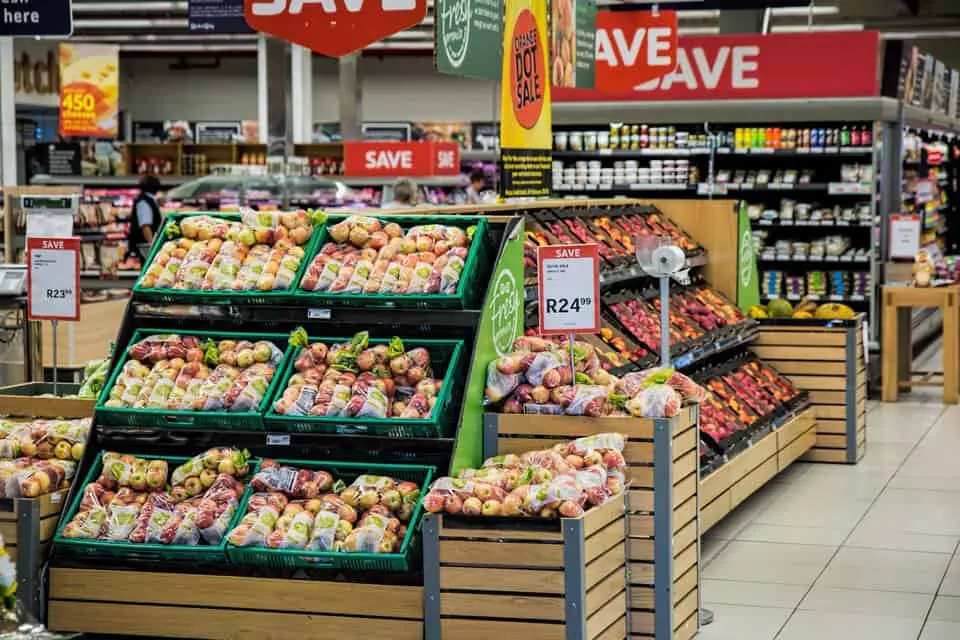“This post may contain affiliate links. Please read my disclosure for more info.
We’ve talked here before about how to save money on groceries. But when you consider that food costs are the second or third most expensive item for the average family each month, it seems worthwhile to keep uncovering new ways to save money on groceries.
Most of your bills are pretty rigid. There’s not a lot you can do to change your mortgage or rent, other than refinance or move. But food costs are the most flexible of all of our expenses. Without having a strategy, food will be the black hole where money disappears that could have funded your 401k or your emergency fund. But with a strategy, you’ll see several hundred more dollars in your pocket each month.
We keep harping here on Common Cents Hub, that it’s so vital to have an emergency fund and contribute to savings each month. So if you’re having trouble doing that, then your grocery budget is where you’ll find that money.
So to save money on groceries and keep several hundred more dollars in your pocket, keep these points in mind.
Table of Contents
Know That You’re Being Analyzed
Talk to any successful coach and they’ll tell you one of the keys to their success is studying the competition. Getting familiar with every nuance and tendency of their opponent, so they have every advantage possible.
Did you know there’s actually a term called grocery store analytics? Store managers are planning for your next visit. Your main motive may be to save money on groceries, but theirs is to squeeze every cent they can out of you.
Those bar-coded loyalty cards we keep on our keychains are good for discounts, but they also tell the store:
- What day you’ll likely be in.
- What you buy.
- What aisles you frequent.
- Even what shelves you pick things from.
They’ve spent hours designing the floor layout to funnel you past those great smelling cookies for $6 a box, while putting the milk and bread at the far end of the store.
Getting Our Game On to Save Money on Groceries
Since our shopping tendencies are being studied so closely, it makes sense to have our own plan of attack if we really want to save.
Here’s how we can save money on groceries by devising our own plan.
- Take all food purchases, from every source into account. Have a holistic approach.
- Don’t go to the store with just a post-it note – Go with a plan.
- Know your store.
- Know your prices.
Have a Holistic Approach to Buying Food
I don’t mean to start buying only berries and granola. Although if that’s what you like, great. I mean, treat all food purchases under one umbrella. Groceries, take-out food, sit-down restaurants, work lunches and convenience stores.
It may seem like we’re saving money on groceries by scrimping at the store, but if we don’t buy what we need for each meal, all we’re doing is transferring that cost (and more) into work lunches, take-out food, convenience stores and restaurants. We add literally hundreds of dollars to our budget by not considering all food expenses together.
Save Money on Groceries By Having a Plan
Not many people food shop with a plan. And by a plan, I don’t mean taking a quick scan in the fridge and jotting down half a dozen things on a post-it note.
Think about it. If you have the opportunity to save money on groceries – like several hundred dollars per month, isn’t it worth your time to spend fifteen minutes once a week to write down a meal for each day and what you’ll need for it?
Really, it’s not that hard. You probably already have a few meals in mind that you and your family like. Here’s one way you can start:
- Take a notebook and write down about 12-15 dinners you’d like, with sides.
- Write down the ingredients you’ll need for each meal.
- When you write the ingredients, take into account leftovers you can use for lunch.
- Write some quick breakfast and lunch items like cereal, fruit, bagels, yogurt, PB&J.
Now you have a go-to list that you can save and refer to each week. So, the night before you shop, just pick from your list and write a week’s worth of dinners for that week on a new page. Now check the ingredients for those meals against what you have, and make your shopping list.
Here’s what you’ll start to notice:
- You won’t have that “what am I going to make” worry in the back of your head all day.
- You’ll eliminate the $25 emergency take-out runs because there’s nothing to make.
- You’ll have lunch items instead of blowing $5-$10 every day.
- You’ll eliminate the extra trips to the grocery store where you spend triple what you planned.
- At the end of the month, you’ll start noticing a few hundred more dollars in your account.
Save Money on Groceries by Knowing Your Store
- When you make your list, group similar things like dairy, fruits and meats. If you can avoid backtracking through aisles you’ll spend less on impulse buys.
- The best fruits and veggies aren’t always the prettiest. Some store produce is picked while it’s still green, and then sprayed with ethylene gas at the store to brighten it up. So, sometimes the faded ones are cheaper and better tasting.
- Is that 6-pack of drinks now suddenly only available as a 12 pack? That’s probably because people are inclined to drink more if they have more.
- Save money on cheeses by finding the same ones that the deli has, over in the dairy section.
- If you need a birthday or some other cake, order it ahead of time instead of buying from the display case. It’ll be the same price, but made fresh.
- Think twice about the prepared foods section. In addition to being really expensive, a lot of the foods are recycled from the shelves because they’re nearing expiration.
- Try to avoid things like sliced fresh fruit and instead, buy the whole thing and slice it yourself. You’ll buy more for almost half the price.
Save Money on Groceries by Knowing Your Prices
- According to a supermarket pro, buy one get one half off isn’t all that great. That’s only 25% off each. Their real sales will feature 50% off without buying a second one.
- Make a list of the 8-10 most common items you buy, and get used to the prices. You might find that it’s worth an extra trip to Aldi’s or another discount store in the area for a few of them.
- Double check that sale item to make sure it’s the right size box or bag. Sometimes a sale sign will be placed right between two sizes of the item, and it’s easy to grab the wrong one..
- Don’t assume that 5 for $5 or 10 for $10 is a good price. You may not need to buy 5 or 10 to get that price. Or one may even be cheaper than $1.
- If you’re a coffee drinker, K-cups may be easy, but according to Business Insider, they’ll cost you about 4 times the price of bagged coffee over the course of a year.
- Are you active or ex-military? If you or your spouse is, you can save money on groceries with a military discount.
- Use the self-checkout lines when you can. The IHL Consulting group found that impulse purchases dropped by 32% for women and about 17% for men when using the self-checkout line. I’ve hesitated with this before when I’ve had fruits or vegetables that need to be weighed, but it’s really pretty easy.
How to Save Money on Groceries With Coupons
If you don’t like the idea of cutting coupons and bringing them with you, here’s a few good alternatives. And you can do these from home, from work, even on the side of the soccer field.
- Go to the website for the store you shop at, and check their weekly digital coupons. Just select the products you’ll be buying, and when you check out at the store with your loyalty card, you’ll receive the discount.
- You can also use the free app Ibotta where they put out a new batch of rebated products each week. It’s the same process. Just select the items you’ll be buying, and when you get home, take a picture of your receipt and submit it. Done. Your rebates are sent to your PayPal account. What’s nice is, that you can get Ibotta rebates even though you’ve already received manufacturer’s rebates. And they’ll give you $10 just for signing up.
Final Points
The single biggest opportunity to maximize our paycheck each week, is to save money on groceries. And the biggest roadblock in our effort to save money on groceries is not having a plan. We’re all rushed, so it’s easy to think that you don’t have time to plan meals.
But the truth is, once you get used to taking 15 minutes to plan your week, you’ll be surprised to see that you actually have more time. Eliminating extra trips to the store, and having to come up with something each night, takes a lot of stress off your plate.
And when you can save money on groceries – enough to start building some savings, your entire financial situation can start to take a positive uptick.
So here’s your homework:
- Grab a notebook and write down at least 12-15 meals with ingredients. This one time, it may take you a bit longer than 15 minutes.
- Consider leftovers when you’re writing the ingredients.
- Add some quick breakfast or lunch staples you can have on hand.
That’s the basis for your plan. Now, each week:
- Check your store’s website for any especially good bargains. Or check Ibotta for the same.
- Pick 5-7 dinners from your list of meals. If there’s a good coupon for something, include that in your menu.
- Pick a few quick breakfast items, and for lunch either pick a few quick items or plan for leftovers.
- From your list of meals, list the ingredients you’ll need. Check your kitchen inventory and jot down what you’ll need to buy.
Now you have your shopping list. And now you’ll walk into the store once this week. You’ll know exactly what you’re buying. You’ll come home knowing that you’re done and your week is planned. You can even hang the weekly menu so there’s no surprises. Everyone will know what’s for dinner all week.
It’s nice to splurge on dinner out once in a while, but eliminating the times when you need to, can be the emergency fund you thought you couldn’t afford. Or the monthly 401k deposit you can’t seem to find. Or even that vacation you need.
Have you tried to plan meals to cut down your food costs? How did it work out for you? Or if you’re in the process, let us know your results!
Related topics:



